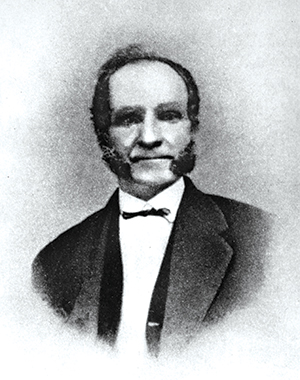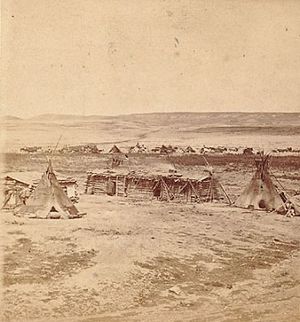Charles Larpenteur facts for kids
Quick facts for kids
Charles Eugene Larpenteur
|
|
|---|---|
 |
|
| Born | May 8, 1803 |
| Died | November 15, 1872 (aged 69) |
| Nationality | French |
| Citizenship | American |
| Occupation | Fur trader |
| Known for | His memoir, Forty Years a Fur Trader |
| Spouse(s) |
|
| Parent(s) |
|
Charles Larpenteur (1803–1872) was an important American fur trader. His detailed memoir (a written account of his life) and diary are often used by historians to learn about the history of the fur trade in America.
Life as a Fur Trader
Charles Larpenteur was born in France. His father, a supporter of Napoleon, moved the family to Baltimore, USA, after Napoleon's rule ended. As a young man, Charles moved to St. Louis, which was a major center for the fur trade.
In 1833, Larpenteur began working as a common engagé (a hired worker) for the Rocky Mountain Fur Company. He traveled with them to the Green River rendezvous, a big meeting place where fur traders and Native Americans exchanged goods.
After this, his group continued to the Yellowstone River. There, they built Fort William near an existing trading post called Fort Union, which belonged to a rival company, the American Fur Company. Soon after Fort William was finished, it was sold to the American Fur Company. Larpenteur then became a clerk (someone who keeps records and manages business) at Fort Union.
He worked for the American Fur Company and its later versions for many years, mostly at Fort Union. During this time, Larpenteur even built another trading post called Fort Alexander for the Crow people on the Yellowstone River.
In 1860, Larpenteur became a partner in his own fur trading business, called Larpenteur, Smith & Company. They traveled west and Larpenteur set up a trading post at Poplar River. The company later changed its name to Larpenteur, Lemon & Company.
By 1864, Larpenteur was back at Fort Union, this time as the Bourgeois (manager). However, the fort was soon sold to a new company, and Larpenteur left. He later worked as an Assiniboine interpreter for a peace commission and then as a fur trader for another company.
In 1869, Larpenteur moved his family from Iowa to Fort Buford and started a trading post there. However, new rules in 1870 limited traders at military posts. Larpenteur's request to continue trading was denied, so he returned with his family to Iowa, where he passed away in 1872.
His Diary and Memoir
Throughout his forty years in the fur trade, Charles Larpenteur carefully kept a diary. He used this diary to help him remember details when he later wrote his memoir, which was a longer story of his life and experiences.
Larpenteur couldn't find a way to publish his memoir himself. So, he sent his handwritten story to Washington Matthews, an army surgeon he knew. Later, Matthews passed the manuscript to Elliott Coues. Coues edited the memoir, adding his own notes, and it was published in 1898.
Years later, another editor named Milo Quaife re-edited Larpenteur's manuscript. Quaife tried to make his version as close to Larpenteur's original writing as possible. This version was published in 1933.
Coues had also seen Larpenteur's original diary and other papers. However, the original diary itself was not published until 2007. Today, three of Larpenteur's original diaries and a cashbook are kept at the Minnesota Historical Society.
Family Life
Charles Larpenteur was married three times. His first wife was an Assiniboine woman who died in 1837; her name is not known today. His second wife was another Assiniboine woman named Makes Cloud. They had five children together. Sadly, she was killed by the Omaha in 1853. His third wife was an American widow named Rebecca Bingham, and they had one child. Sadly, all of Larpenteur's children passed away before him.
Larpenteur started a farm near Little Sioux, Iowa. He named it Fontainebleau, after his birthplace in France. This is where his second wife was killed while picking berries.


